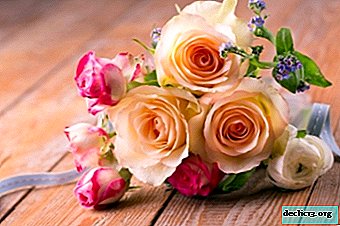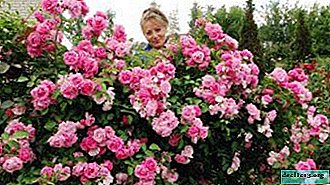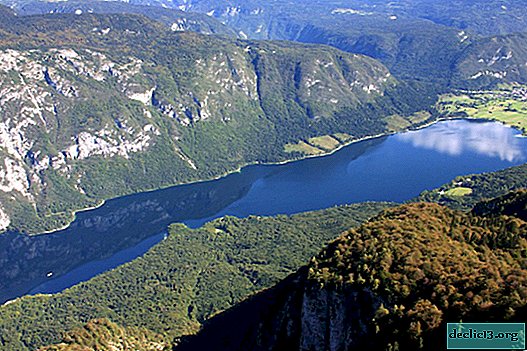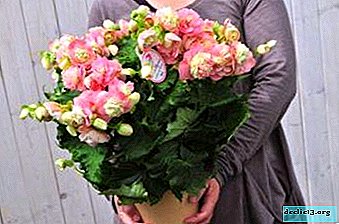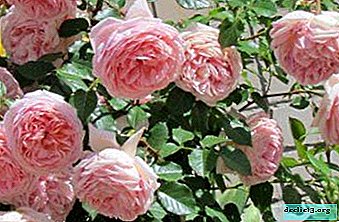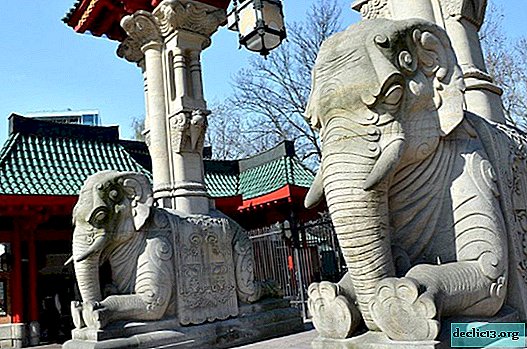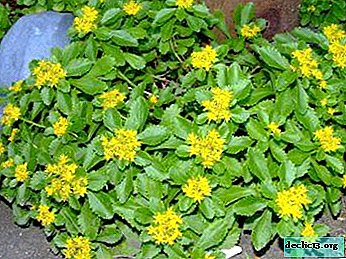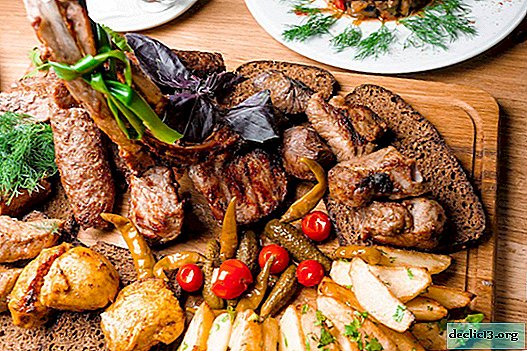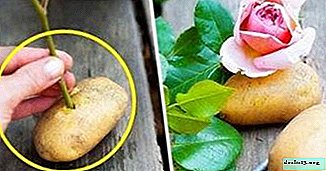Beautiful roses Kerio: description and photo varieties, flowering and use in landscaping, care and other nuances
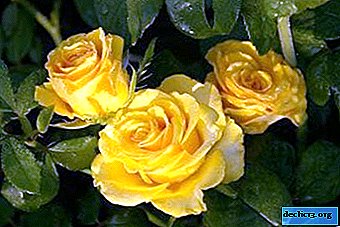
One of the most beloved, and often preferred as a compliment to a significant event flowers, are rightfully considered roses. It is rare to meet a woman who would not like these delicate and fragrant flowers.
Unfortunately, roses in a vase tend to wilt quickly, but if you wish, you can plant and grow these amazing flowers on your own. One of the best options for planting is the world-famous Kerio rose.
Grade description
Rosa Kerio is a hybrid tea variety. Kerio cutting variety is distinguished by massive and developed bushes and a minimum number of thorns. The height of the bush is 1.20 meters, and the width reaches 60 centimeters. The foliage of this variety has a bright, rich green hue. In rare cases, the leaves may become burgundy.
The shape of the flower is a glass with a diameter of 13 to 16 centimeters. The color of the petals is saturated yellow, in too bright sunlight the petals can fade to light lemon. In one bud, from 35 to 50 petals are located. When the Kerio rose opens, its middle disappears from view.
The fragrance is light and weightless. This variety is resistant to cold and disease.. The buds open slowly, due to which they keep their shape perfectly. Cut roses remain fresh for about 10 days.
We offer you to watch a video with a description of the variety Kerio:
Photo
Further on the photo you can see what the Kerio rose looks like.




History of occurrence
The Kerio rose variety was bred in the Dutch rose company Lex + in 2002. Its registration name is Lexoirek. The company is widely known for its rich variety of bred varieties of roses; it is a multiple winner of prestigious international prizes.
Reference! Rosa Kerio is considered one of the business cards of the company, because in addition to its excellent appearance, this variety also has a lot of positive properties.What is the difference from the rest of the species?
Unlike other types of roses, Kerio roses in the middle lane have 2-3 flowering waves. The buds of this kind of roses have an almost perfect shape with an elongated core. These roses are one of the best cuts. The bushes are erect, lush, on the shoots there are almost no thorns.
Bloom
- When and how? Roses bloom magnificently in the form of single flowers, in more rare cases, inflorescences (4 pcs.). This variety blooms throughout the warm season. The beginning of flowering is June. Flowering occurs repeatedly, while it is long and frequent.
- Care before and after flowering. The main care is top dressing, pruning and watering. Roses are fed 2 times per season: in May, complex fertilizers with microelements and nitrogen fertilizers are used before flowering, and after the first flowering in July, fertilizers with phosphorus and potassium. Freshly planted roses, like blooming ones, do not fertilize.
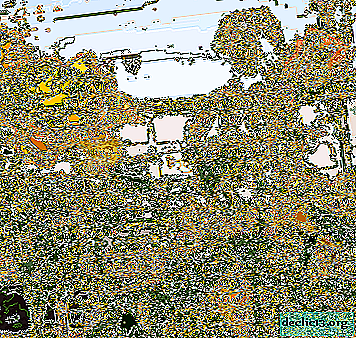 What to do if it does not bloom? Each shoot of a healthy rose, each shoot ends with a bud or inflorescence. Possible reasons why roses may not bloom:
What to do if it does not bloom? Each shoot of a healthy rose, each shoot ends with a bud or inflorescence. Possible reasons why roses may not bloom:- first year of planting;
- Incorrect landing site
- improper pruning or care;
- root shoots;
- bacterial burn;
- aging.
An ambulance can be provided to the plant by removing unnecessary shoots, making stimulating pruning to a strong kidney, and fertilizing the plant with fertilizer with potassium.
Use in landscape design
In open ground, high Kerio roses are suitable for rabatok and groups, and undersized bushes for creating borders.
Step-by-step care instructions
- Choosing a landing place. A well-chosen landing site plays one of the key roles. Flower growing experts recommend choosing places on the sunny side for this variety, but not exposed to strong winds.
- Landing time. Planting stock should be purchased at the end of March or April. The recommended time for planting is the beginning of May (if the soil is warm enough).
- What should be the soil? Kerio roses need a slightly loose and moist soil. The recommended acid-base reaction of the soil is from 5.6 to 7.3 pH. The soil should be filled with a nutrient mixture (sand, peat, manure and fertile soil can be used). Nutrient formula can be purchased at a specialty store.
- Landing. When buying rose seedlings, you need to pay attention to the fact that the root system is closed, and the aerial part of the flower is quite well developed. Before planting, seedlings must be kept in water (no more than 6 hours). Shoots need to be cut.
The depth of the landing pits should be from 45 to 55 cm, and the permissible distance between the pits is 40 cm. The roots should be located freely. First you need to prepare a drain to avoid possible stagnation of water. When planting, the root neck cannot be deeply buried. After planting, the flower must be watered and shaded for 14 days.
- Temperature. Do not allow overheating or overdrying of the flower, as well as hypothermia of the rhizome. The minimum allowable temperature is 8 degrees, the maximum + 30-40. The most optimal is considered the average temperature in the region of +20 degrees.
- Watering. Excess moisture can damage the flowers, the average number of waterings - 3 times a week. The bush needs to be watered both in summer and in autumn. For watering, water that has settled well (at least a day) is well suited. Water temperature - 16 degrees.
 Top dressing. Both manure and mineral fertilizers are suitable for feeding. In spring, nitrogen fertilizers are used, and before flowering, potash and phosphorus. If the plant was replanted, a month after the procedure, additional abundant dressing is required, which must be repeated after 14 days.
Top dressing. Both manure and mineral fertilizers are suitable for feeding. In spring, nitrogen fertilizers are used, and before flowering, potash and phosphorus. If the plant was replanted, a month after the procedure, additional abundant dressing is required, which must be repeated after 14 days.- Pruning. Trimming is one of the most important procedures. Trimming is done to form basal shoots and form a bush with a uniform arrangement of stems. Trimming is carried out with a sharp tool, the distance from the kidney is 0.5 centimeters. The most powerful stems are shortened to 4-6 buds, and standard ones to 2-4.
- Transfer. For better development and flowering, it is recommended to transplant Kerio roses during the growing moon. If the flower was purchased recently, the transplant should be temporarily postponed until complete adaptation. When transplanting, it is necessary to use nutritious soil specially designed for roses. A few centimeter layer of drainage is also needed.
During transplantation, only part of the earthen coma is removed. During the procedure, it is necessary to ensure that the rhizome is not damaged. The optimal pot for transplanting is ceramic, slightly larger in size than the previous container. A new pot is pre-soaked in water. Before transplanting, the flower needs watering, after transplanting - spraying of foliage.
- Preparation for winter. This variety of roses is resistant to low temperatures and cold, but still, during the winter period, flowers need to be covered. Shelter roses can be immediately established as a negative temperature. Before this, it is necessary to clean the bushes. Also, before shelter, it is favorable to remove the tips of unripe shoots and parts of the plant affected by diseases (if any). The bush must first be spudded with loose dry earth.
Breeding
Rosa Kerio propagated by cuttings. Cuttings can be taken directly from the rose bush. For cuttings, methods such as the Burito methods and the Trannua method are used, and rooting of the cuttings can also be done. Rooting is carried out in the summer in the open ground. The time for cutting is morning or evening hours. The best option is faded or vice versa only blooming semi-lignified stems. Spikes should break easily.
The length of the cuttings is from 12 to 15 centimeters. There should be no flowers on the cuttings. An oblique cut is made under the node located below, and 20 millimeters above the top node. For better moisture retention, the remaining leaves must be removed or shortened (the remainder is 1/3 part).
Diseases and Pests
The advantages of this type include the fact that This rose variety is not affected by powdery mildew and rust.. The greatest threat to her is a parasite such as aphids.
 To combat it, mechanical, chemical, as well as folk remedies are used. The easiest mechanical way - a normal stream of water of medium power.
To combat it, mechanical, chemical, as well as folk remedies are used. The easiest mechanical way - a normal stream of water of medium power.
For chemical treatment (aerial parts of the flower) are used:
- "Aktara";
- Kinmix
- "Spark";
- "Fitoverm".
As folk methods, infusions of potato tops, tomatoes, garlic, onions, tobacco and red pepper are used.
Thanks to the above recommendations, even without sufficient experience, you can grow a healthy and beautiful plant, which for a long time will delight the flowering of bright yellow flowers.

 What to do if it does not bloom? Each shoot of a healthy rose, each shoot ends with a bud or inflorescence. Possible reasons why roses may not bloom:
What to do if it does not bloom? Each shoot of a healthy rose, each shoot ends with a bud or inflorescence. Possible reasons why roses may not bloom: Top dressing. Both manure and mineral fertilizers are suitable for feeding. In spring, nitrogen fertilizers are used, and before flowering, potash and phosphorus. If the plant was replanted, a month after the procedure, additional abundant dressing is required, which must be repeated after 14 days.
Top dressing. Both manure and mineral fertilizers are suitable for feeding. In spring, nitrogen fertilizers are used, and before flowering, potash and phosphorus. If the plant was replanted, a month after the procedure, additional abundant dressing is required, which must be repeated after 14 days.
